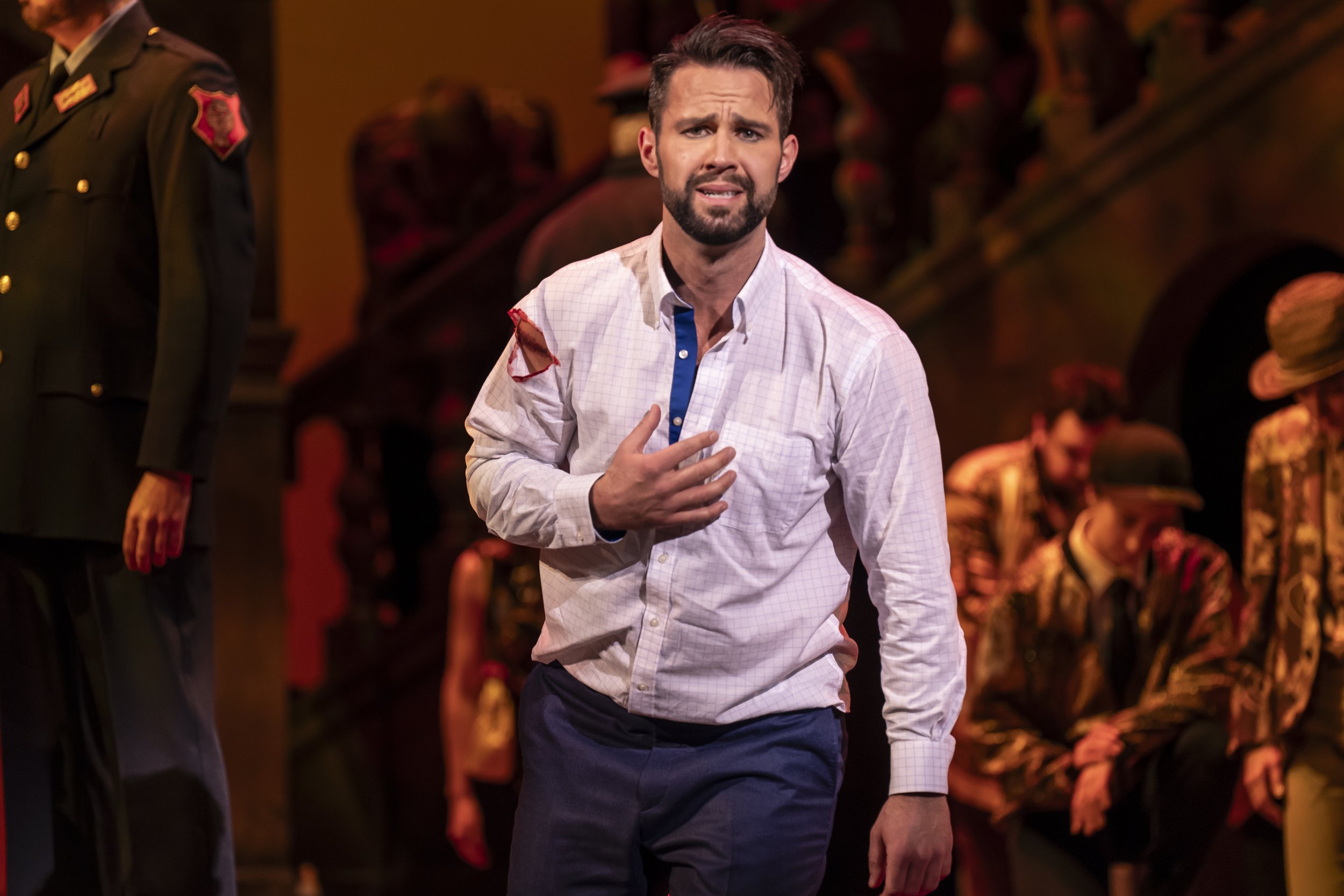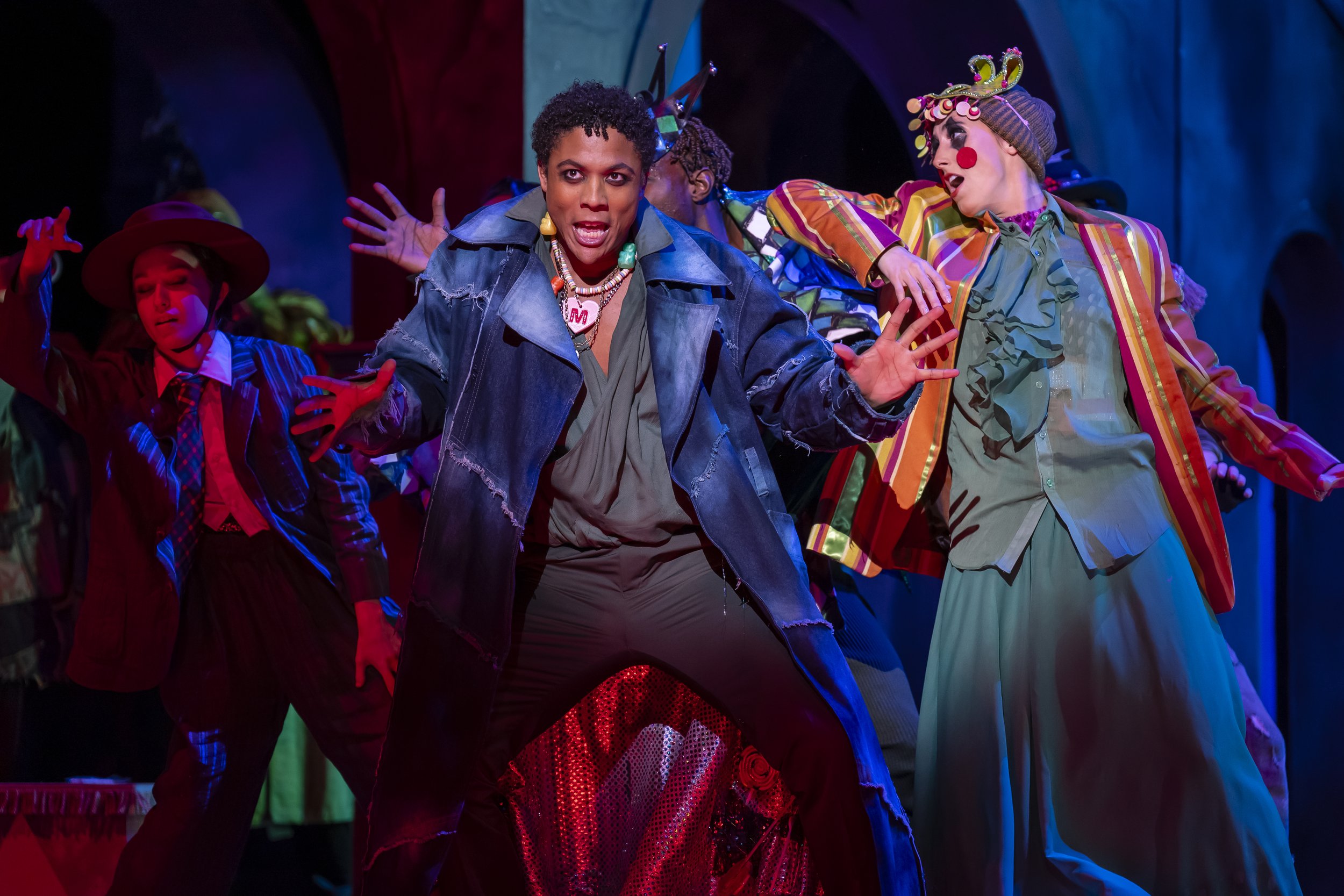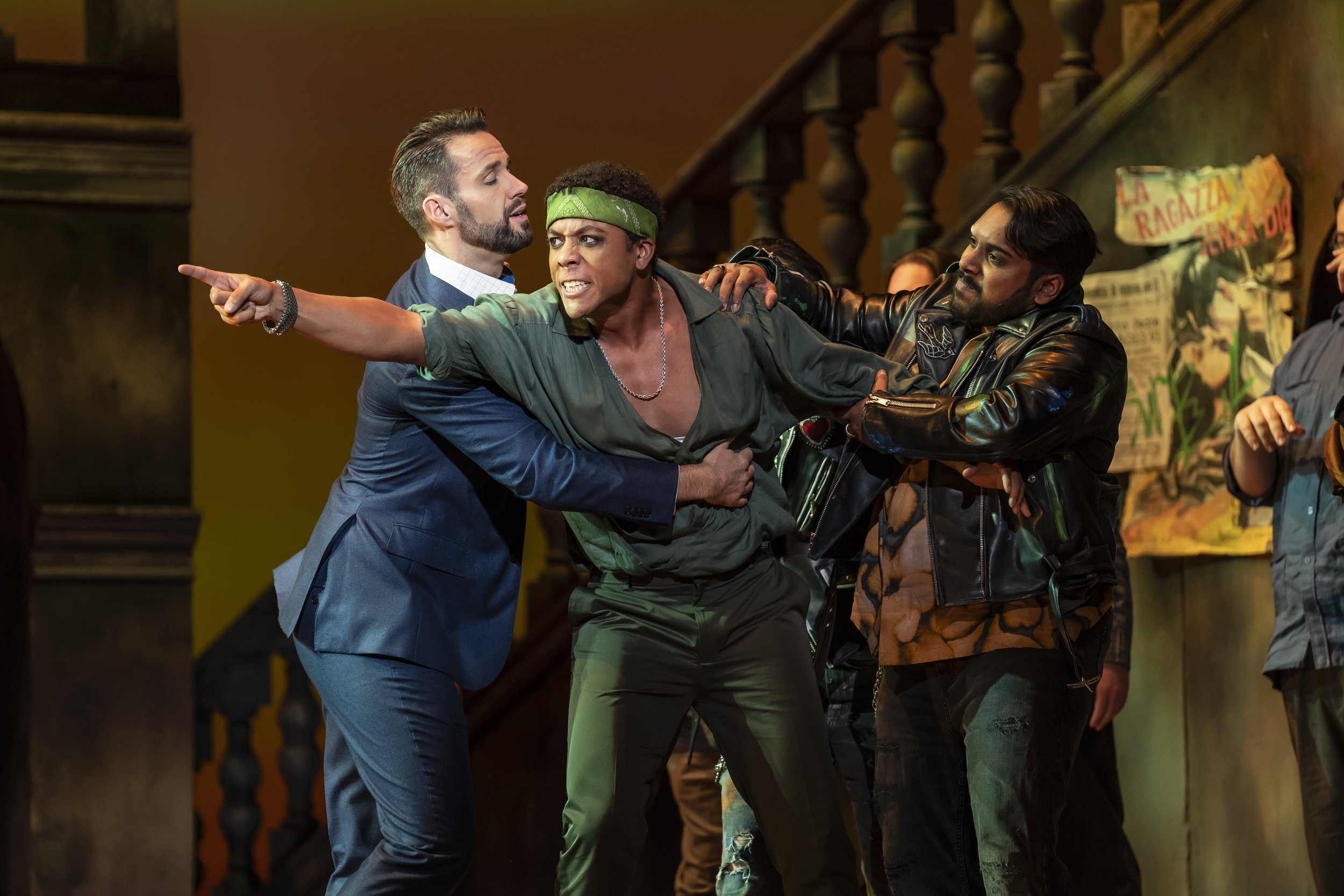With all the beautiful music, singing, and staging, tragically, Romeo didn’t get the memo. As a bona fide user of social media, I feel like it is my responsibility to use the entirety of this report to attack, in harsh and vulgar and capitalized terms, Frére Laurent, the well-meaning friar who failed, I say FAILED, to get the word to Romeo that Juliet just looked dead but was not dead. I repeat – NOT DEAD! It was kind of important for him to know that as I will explain. It is also my responsibility, nonetheless, to be more balanced for my readers’ sake. After all, stuff happens, and besides, we don’t know the details. With that off my chest, here goes:
Rosa Feola as Juliet in center of ring in party scene from Washington National Opera’s Romeo and Juliet. Photo by Scott Suchman; courtesy of Washington National Opera.
French composer Charles Gounod led an interesting life and managed to write two operas that still get performed regularly today, this one and Faust (1859); as the popularity of Faust has waned, that of Romeo and Juliet (1867) has grown worldwide; of his twelve-opera total, his first opera, Sapho, also occasionally gets produced. Gounod won the Prix de Paris award for composers when he was only twenty which offered him training in Italy and made additional travel in Europe possible. His interest was mainly sacred music; his “Ave Maria” is one of the famous versions of the hymn; the composer had a gift for writing beautiful music. At the age of 28, he entered a seminary to train for the priesthood; he left when he discovered that celibacy was not his thing. He was befriended by famed mezzo-soprano and socialite Pauline Viardot, who got him started in opera with Sapho. This led to favor with impresario Léon Carvalho and introductions to other elites of the Parisian musical establishment, including librettists Jules Barbier and Michel Carré, who worked with him on both Faust and Romeo and Juliet. At the height of his fame, he was considered the leading composer in France.
Romeo (Adam Smith) and Juliet (Rosa Feola). Photos by Scott Suchman; courtesy of Washington National Opera.
Librettists Barbier and Carré used Shakespeare’s play as their source and stayed close to it. The great Bard’s story of young lovers who cannot be together because they are from rival, warring families, and that wind up committing suicide together, is an all-time classic, presented in uncountable productions of the play and many adaptations in movies, musicals, and operas. Among the significant changes by the librettists, only Juliet and Romeo are in the Capulet crypt scene, and Juliet wakes up before Romeo’s death to allow for a nice romantic duet and more time for the audience to shed tears. As a reminder, the friar’s scheme to help the young lovers escape is to have Juliet take a potion making her look dead; then he and Romeo will revive her in the crypt; alas, Romeo doesn’t get the memo and takes a poison when he discovers her body in the tomb…but she then wakes up, and when Romeo dies, she plunges a knife into her chest so that they will remain together forever. Frankly, with so many deadly conflicts going on today, I was praying that WNO had changed the ending, but no, that was not to be, and I am left to harshly critisize Frére Laurent.
Juliette (Rosa Feola) and Romeo (Adam Smith) in balcony scene. Photo by Scott Suchman; courtesy of Washington National Opera.
Ms. Feola as Juliet lived up to her star diva billing. Her early on singing of the opera’s pop hit aria, “Je veux vivre” was a delightful, lyrical pleasure. Ms. Feola is not a belter; she sings with grace and texture and enjoyable clarity, bringing the nature of Juliet more fully to life. The surprise of the evening to me was just how good tenor Adam Smith was who played Romeo; he was an outstanding pairing with Ms. Feola. He proved to be a pure voiced tenor with excellent vocal power and a strong stage presence. I wanted to hit replay on their duet on the balcony late in Part One, a scene where the beautiful couple also displayed youthful agility scaling the wall. It was not the only time I wanted to hit replay for their arias and duets.
The supporting cast was also strong: I will single out just a few. Justin Austin made for a rather endearing Mercutio, a friend who loses his life defending Romeo’s honor. You might remember this young singer’s recent appearance in WNO’s American Opera Initiative’s American Apollo; he is this year’s winner of the Marian Anderson Award. Tenor Duke Kim, also an AOI alumni, was excellent as hot-headed Tybalt, though casual business attire made his character more difficult to believe for me. Mezzo-soprano Jill Grove as Gertrude, Juliet’s nurse, was a magnet for attention anytime she was singing or just on stage. Bass Nicolas Testé sang the roles for both the Duke of Verona and Frére Laurent. His beautiful voice and singing readily take command of the stage, making me even more baffled that the friar failed to get the memo to Romeo. Lastly, I will mention mezzo-soprano Winona Martin, a veteran of Wolf Trap Opera who sang the role of Stéphano, a friend/defender of Romeo; her singing of “Que fais-tue, blanch tourterelle” was a standout.
Two views of Mercutio (Justin Austin), party crashing and engaged in deadly combat(includes Adam Smith as Romeo and Kevin Punnackal as Benvolio). Photos by Scott Suchman; courtesy of Washington National Opera.
The Washington National Opera Orchestra under the direction of Conductor Evan Rogister gave an outstanding performance. Gounod’s marvelous music was played with beauty and sensitivity, expertly partnering with and not overwhelming the singers. Shakespeare’s Romeo and Juliet was a perfect match of composer with story. The orchestra was a joy from beginning to end. The large WNO chorus was also a delight under the steady hand of Chorus Master Steven Gathman. The opera opens with both a dramatic overture by the orchestra and a grave prologue by the chorus.
The Director for WNO’s production was Simon Godwin, the Artistic Director for DC’s acclaimed Shakespeare Theater Company; this was his entrance into directing opera. His talent as a theater director was evident throughout this excellent performance; exceptionally well played was the ending scene between Romeo and Juliet. Mr. Godwin chose costumes of the mid to late twentieth century to make the story seem more current but kept the setting Veronese; it worked, kudos to Costume Designer Loren Shaw. The opening party scene was eye catching and circus like, clearly the Capulets were well off. The set was romantic, mostly lovely stone and arches bathed in soft glowing light; kudos to Set Designer Daniel Soule and Lighting Designer Robert Wierzel. Scrims were used to open most scenes with mood defining smoky movement, dramatically used at the end of Part One to foreshadow the tumult to come; kudos to Projection Designer Blake Manns. The party scene and the Mercutio/Tybalt fight were very well done, kudos to Choreographer Jonathan Goddard.
Juliet (Rosa Feola) and Romeo (Adam Smith) in a dying embrace in the Capulet crypt. Photo by Scott Suchman; courtesy of Washington National Opera.
I was greatly looking forward to attending Washington National Opera’s production of Romeo and Juliet. Composer Charles Gounod’s music is simply beautiful throughout, and it was my first opportunity to hear the highly acclaimed soprano, Rosa Feola. I got all that and more. It was a particularly rewarding artistic experience. Maybe at some point I will forgive the good friar…but don’t hold your breath.
The Fan Experience: Romeo and Juliet was scheduled for performances in the Kennedy Center’s Opera House on November 4, 6, 10, 12, 15, 17, and 18. The November 17 performance will feature WNO’s Cafritz Young Artists in the lead roles. The opera is sung in French with supertitles shown overhead; it lasts about 2.5 hours in addition to a 25 minute intermission. Tickets for remaining performances are available at this link.
WNO’s Romeo and Juliet is a co-production with the The Glimmerglass Festival where the opera was performed this past summer. It is also part of the DC-wide Shakespeare Everywhere Festival; details at this link.
Half hour pre-opera talks are given to ticket holders one hour before performances. Post-performance question and answer sessions were scheduled with members of the cast on November 6 and 2.
Parking in the Kennedy Center is typically plentiful at around $25 per day, with a small discount for Kennedy Center members when reserved ahead of the day. The Metro to Foggy Bottom and the free red Kennedy Center buses, from there to the Kennedy Center runnning every 15 minutes, are an excellent option. There are snack stands in the main lobby, and on the Terrace level, the KC Café offers food cafeteria style at moderate prices; fine dining is available on the Terrace level in the Roof Terrace Restaurant. Food and drinks except water are not allowed inside the opera house, but you can purchase reusable containers with your drinks that you can take inside.







